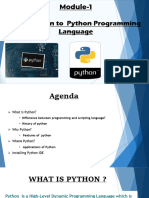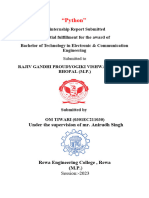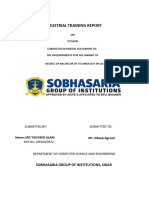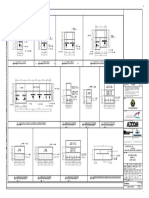0 ratings0% found this document useful (0 votes)
4 viewsPython Presentation
Uploaded by
esraaanabgagCopyright
© © All Rights Reserved
We take content rights seriously. If you suspect this is your content, claim it here.
Available Formats
Download as PPTX, PDF, TXT or read online on Scribd
0 ratings0% found this document useful (0 votes)
4 viewsPython Presentation
Uploaded by
esraaanabgagCopyright
© © All Rights Reserved
We take content rights seriously. If you suspect this is your content, claim it here.
Available Formats
Download as PPTX, PDF, TXT or read online on Scribd
You are on page 1/ 10
Python Programming Language
A Versatile and Powerful Tool for
Modern Development
Introduction
• What is Python?
• - Python is a high-level, interpreted
programming language.
• - Created in 1991 by Guido van Rossum.
• - Designed to emphasize readability and
simplicity.
• - Widely used in various domains like web
development, data analysis, AI, and more.
Key Features
• Why Choose Python?
• 1. Easy to Learn and Use: Simple syntax,
perfect for beginners.
• 2. Versatile: Supports multiple programming
paradigms.
• 3. Rich Libraries: Offers a vast collection of
libraries (e.g., NumPy, Pandas).
• 4. Platform Independent: Runs on Windows,
macOS, Linux.
• 5. Community Support: Backed by a large
Applications of Python
• Where is Python Used?
• 1. Web Development: Frameworks like Django
and Flask.
• 2. Data Analysis and Visualization: Tools like
Pandas, Matplotlib.
• 3. AI and Machine Learning: TensorFlow,
Scikit-learn.
• 4. Game Development: Libraries like Pygame.
• 5. Automation: Automating repetitive tasks
with scripts.
Example Code
• Simple Python Code:
• ```python
• # Print a greeting
• print("Hello, World!")
• # Calculate even numbers between 1 and 10
• for i in range(1, 11):
• if i % 2 == 0:
• print(i)
Advantages of Python
• 1. Readability: Clean and easy-to-understand
code.
• 2. Flexibility: Suitable for a wide range of
applications.
• 3. Scalability: Handles small scripts to large
applications.
• 4. Extensibility: Supports integration with
other languages like C, C++.
• 5. Cost-Effective: Open-source and free to use.
Limitations of Python
• 1. Performance: Slower than compiled
languages like C++.
• 2. Mobile Development: Not ideal for mobile
applications.
• 3. Memory Consumption: Uses more memory
compared to other languages.
• 4. Concurrency: Limited support for
multithreading.
Comparison with Other Languages
• | Feature | Python | C++ | Java
|
• |------------------|-----------|------------|-------------|
• | Ease of Learning | Very High | Medium |
Medium |
• | Speed | Moderate | High |
Moderate |
• | Application Areas| Diverse | Performance|
Enterprise |
• | Community Support| Excellent | Good |
Future of Python
• - AI and Machine Learning: Continued
dominance in data-driven fields.
• - Education: Increasing popularity as a
beginner-friendly language.
• - Web and Automation: Widespread adoption
in web frameworks and task automation.
• - Enterprise Solutions: Growing use in large-
scale applications.
Closing Slide
• Why Learn Python?
• - Python is versatile, beginner-friendly, and
powerful.
• - It is the go-to language for data science, AI,
web development, and more.
• - Mastering Python can open countless
opportunities in the tech world.
• Thank You!
You might also like
- DD10.1.1 Adv 202006 LG e 637291407447284514No ratings yetDD10.1.1 Adv 202006 LG e 637291407447284514113 pages
- PCS-996S-A - PMU - DataSheet - EN - Overseas General - X - R1.00No ratings yetPCS-996S-A - PMU - DataSheet - EN - Overseas General - X - R1.0037 pages
- " E-Commerce Website": Final Project Report0% (1)" E-Commerce Website": Final Project Report37 pages
- Python Programming For Beginners: Learn The Basics Of Python Programming (Python Crash Course, Programming for Dummies)From EverandPython Programming For Beginners: Learn The Basics Of Python Programming (Python Crash Course, Programming for Dummies)5/5 (1)
- Chapter - 1 Getting Started With PythonNo ratings yetChapter - 1 Getting Started With Python10 pages
- Employee Management System Project File- Aman Sunesh (1)No ratings yetEmployee Management System Project File- Aman Sunesh (1)47 pages
- NEW NOTE CSC 201 SCIENTIFIC PROGRAMMING LANGUAGENo ratings yetNEW NOTE CSC 201 SCIENTIFIC PROGRAMMING LANGUAGE18 pages
- Python Tutorial - Learn Python Programming For FreeNo ratings yetPython Tutorial - Learn Python Programming For Free6 pages
- Basic Guide to Programming Languages Python, JavaScript, and RubyFrom EverandBasic Guide to Programming Languages Python, JavaScript, and RubyNo ratings yet
- Python for Beginners: The Dummies' Guide to Learn Python Programming. A Practical Reference with Exercises for Newbies and Advanced Developers: Python Programming, #1From EverandPython for Beginners: The Dummies' Guide to Learn Python Programming. A Practical Reference with Exercises for Newbies and Advanced Developers: Python Programming, #1No ratings yet
- Practical Guide to Python: From Basics to Advanced ProgrammingFrom EverandPractical Guide to Python: From Basics to Advanced ProgrammingNo ratings yet
- Gujarat Technological University: Government Engineering College, BhujNo ratings yetGujarat Technological University: Government Engineering College, Bhuj25 pages
- Rohde and Schwarz TSMA6B_bro_en_3609-5622-12_v0600No ratings yetRohde and Schwarz TSMA6B_bro_en_3609-5622-12_v060026 pages
- HW - XERUN XR8 Pro G2 - Manual - en - 210205No ratings yetHW - XERUN XR8 Pro G2 - Manual - en - 2102051 page
- Katalon Studio - Automation Report - Arunkumar GNo ratings yetKatalon Studio - Automation Report - Arunkumar G5 pages
- Documentation: International ST Andards On Technical Document Ation100% (1)Documentation: International ST Andards On Technical Document Ation15 pages
- Solution Manual for Systems Analysis and Design 8th Edition by Kendallpdf download100% (2)Solution Manual for Systems Analysis and Design 8th Edition by Kendallpdf download41 pages
- Road Traffic Act 1988 - Section 80: Ian - Woodruff@vca - Gov.ukNo ratings yetRoad Traffic Act 1988 - Section 80: Ian - Woodruff@vca - Gov.uk52 pages
- An Effective Online Food Order Application System Using Asp .Net Core 3.1 FrameworkNo ratings yetAn Effective Online Food Order Application System Using Asp .Net Core 3.1 Framework4 pages
- Preconfigured DSP System For Hearing Aids RHYTHM R3920: DescriptionNo ratings yetPreconfigured DSP System For Hearing Aids RHYTHM R3920: Description14 pages
- Arduino Based Child Rescue System From Borewells IJERTV7IS020011 PDFNo ratings yetArduino Based Child Rescue System From Borewells IJERTV7IS020011 PDF3 pages
- Building Microsoft Teams Integration and WorkflowsNo ratings yetBuilding Microsoft Teams Integration and Workflows310 pages

























































































